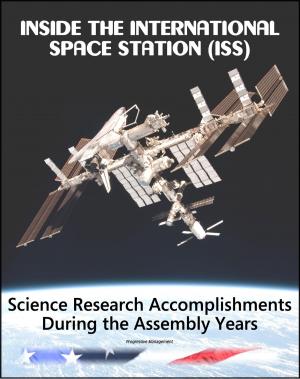Apollo and America's Moon Landing Program: Apollo 1 Tragedy (Grissom, White, and Chaffee) Apollo 204 Pad Fire, Complete Review Board Report, Technical Appendix Material, Medical Analysis Panel
Nonfiction, Science & Nature, Science, Physics, Astronomy, History, Military| Author: | Progressive Management | ISBN: | 9781465835413 |
| Publisher: | Progressive Management | Publication: | November 8, 2011 |
| Imprint: | Smashwords Edition | Language: | English |
| Author: | Progressive Management |
| ISBN: | 9781465835413 |
| Publisher: | Progressive Management |
| Publication: | November 8, 2011 |
| Imprint: | Smashwords Edition |
| Language: | English |
Incorporating a complete reproduction of the final review board report, this authoritative compilation of official NASA documents provides unique insights into NASA s first major tragedy, the Apollo 1 launch pad fire. These documents have been converted for accurate flowing-text e-book format reproduction.
Contents include detailed biographies of the Apollo 1 crew, overview histories of the Apollo 1 tragedy and recovery, the complete final report of the Apollo 204 review board, and excerpts from the technical appendices covering the review board minutes, a detailed narrative description of the sequence of events in the accident, witness statements and releases, and the report of the medical analysis panel.
On January 27, 1967, tragedy struck the Apollo program when a flash fire occurred in command module 012 during a launch pad test of the Apollo/Saturn space vehicle being prepared for the first piloted flight, the AS-204 mission. Three astronauts, Lt. Col. Virgil I. Grissom, a veteran of Mercury and Gemini missions; Lt. Col. Edward H. White, the astronaut who had performed the first United States extravehicular activity during the Gemini program; and Roger B. Chaffee, an astronaut preparing for his first space flight, died in this tragic accident. A seven-member board, under the direction of the NASA Langley Research Center Director, Dr. Floyd L. Thompson, conducted a comprehensive investigation to pinpoint the cause of the fire. The final report, completed in April 1967 was subsequently submitted to the NASA Administrator. The report presented the results of the investigation and made specific recommendations that led to major design and engineering modifications, and revisions to test planning, test discipline, manufacturing processes and procedures, and quality control. With these changes, the overall safety of the command and service module and the lunar module was increased substantially. The AS-204 mission was redesignated Apollo I in honor of the crew. The fire which claimed the lives of Gus Grissom, Ed White and Roger Chaffee stunned the nation and rocked the National Aeronautics and Space Administration. The disaster had the potential to bring a permanent halt to American efforts in space exploration. Rather than bury its head in the sand, NASA launched a full-scale investigation of the fire, and voluntarily put the entire Apollo program, including its administration, policies and procedures under the scrutiny of a review board. Based on the board's findings, NASA rolled up its sleeves and went to work to resolve the problems that had been identified. A successful failure is a mission which fails to reach its objectives and yet still achieves an element of success. Apollo I never left the launch pad. However, the information gained from this fatal mission paved the way for a totally redesigned Apollo spacecraft, eleven Apollo space flights and six lunar landings. Although Grissom, White and Chaffee never walked on the moon, their sacrifice helped to make it possible for us collectively to take "one giant leap for mankind". It is crucial to remember the hard lessons learned from Apollo I and eulogies are part of that remembering. Yet, Grissom, White and Chaffee may be honored best by continuing the work they began. Each of them believed that reaching the moon was not meant to be an end but a beginning. Thirty years ago, Grissom considered manned missions to Mars and crews assembling, living and working on space stations as realistic follow-ups to a lunar landing. While he recognized the place of ever-improving technology, White was emphatic about the need for manned missions: "You'll never satisfy man's curiosity unless a man goes himself."
Incorporating a complete reproduction of the final review board report, this authoritative compilation of official NASA documents provides unique insights into NASA s first major tragedy, the Apollo 1 launch pad fire. These documents have been converted for accurate flowing-text e-book format reproduction.
Contents include detailed biographies of the Apollo 1 crew, overview histories of the Apollo 1 tragedy and recovery, the complete final report of the Apollo 204 review board, and excerpts from the technical appendices covering the review board minutes, a detailed narrative description of the sequence of events in the accident, witness statements and releases, and the report of the medical analysis panel.
On January 27, 1967, tragedy struck the Apollo program when a flash fire occurred in command module 012 during a launch pad test of the Apollo/Saturn space vehicle being prepared for the first piloted flight, the AS-204 mission. Three astronauts, Lt. Col. Virgil I. Grissom, a veteran of Mercury and Gemini missions; Lt. Col. Edward H. White, the astronaut who had performed the first United States extravehicular activity during the Gemini program; and Roger B. Chaffee, an astronaut preparing for his first space flight, died in this tragic accident. A seven-member board, under the direction of the NASA Langley Research Center Director, Dr. Floyd L. Thompson, conducted a comprehensive investigation to pinpoint the cause of the fire. The final report, completed in April 1967 was subsequently submitted to the NASA Administrator. The report presented the results of the investigation and made specific recommendations that led to major design and engineering modifications, and revisions to test planning, test discipline, manufacturing processes and procedures, and quality control. With these changes, the overall safety of the command and service module and the lunar module was increased substantially. The AS-204 mission was redesignated Apollo I in honor of the crew. The fire which claimed the lives of Gus Grissom, Ed White and Roger Chaffee stunned the nation and rocked the National Aeronautics and Space Administration. The disaster had the potential to bring a permanent halt to American efforts in space exploration. Rather than bury its head in the sand, NASA launched a full-scale investigation of the fire, and voluntarily put the entire Apollo program, including its administration, policies and procedures under the scrutiny of a review board. Based on the board's findings, NASA rolled up its sleeves and went to work to resolve the problems that had been identified. A successful failure is a mission which fails to reach its objectives and yet still achieves an element of success. Apollo I never left the launch pad. However, the information gained from this fatal mission paved the way for a totally redesigned Apollo spacecraft, eleven Apollo space flights and six lunar landings. Although Grissom, White and Chaffee never walked on the moon, their sacrifice helped to make it possible for us collectively to take "one giant leap for mankind". It is crucial to remember the hard lessons learned from Apollo I and eulogies are part of that remembering. Yet, Grissom, White and Chaffee may be honored best by continuing the work they began. Each of them believed that reaching the moon was not meant to be an end but a beginning. Thirty years ago, Grissom considered manned missions to Mars and crews assembling, living and working on space stations as realistic follow-ups to a lunar landing. While he recognized the place of ever-improving technology, White was emphatic about the need for manned missions: "You'll never satisfy man's curiosity unless a man goes himself."















